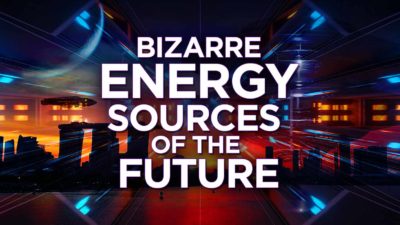Your house is an electricity hog, at least compared to the energy needs of your childhood home. Computers, smartphones, security systems, IoT, smart speakers, gaming consoles, and Bitcoin miners are just some of the electronics that you’ll find in the average home today.
According to the U.S. Energy Information Administration (EIA), the world’s energy needs roughly increase by 1.5 quadrillion BTUs annually. That number is much higher in developing regions and especially in non-OECD (Organization for Economic Co-operation and Development) countries.
If our electricity requirements continue to grow, where is all of this power going to come from to power the cities of the future? Let’s find inspiration from some unusual places including dance clubs and Hollywood movies. Here are some experimental energy sources that just might just become practical energy sources of the future.
Using Human Body Heat To Generate Thermal Energy – The Matrix (1999)
In the groundbreaking sci-fi film, The Matrix (1999), sentient machines have defeated the human race and now rule the planet. Powering this mechanical army are massive human “farms” capable of harvesting thermal body heat and bioelectrical energy.
Maybe the machines from The Matrix were on to something. Eighty percent of our bodies’ power is dispersed as heat. Even a sleeping human generates as much as 100 to 120 watts of energy. This is enough energy to power many of the popular electronics in your home today. If only all of that heat energy could be harnessed.
I’m not suggesting humanity start installing power outlets in the back of our heads just yet, but bioengineers are already experimenting with ways that the human body can help generate electricity.
As far back as 1998, Japanese manufacturer Seiko experimented with a watch called the Seiko Thermic that operated almost entirely off energy derived from body heat. Though the model was only available for a short while, it was a pioneering product in the field of thermal energy.
Harnessing Vibration Energy From Dance Clubs – The Sustainable Dance Club (Netherlands)
In addition to body heat, vibrations from everyday human movement could also be one of the main alternative energy sources of the future.
The Sustainable Dance Club in the Netherlands, has a dance floor that converts the kinetic energy of people dancing into electrical power. Energy Floors, the Dutch company behind the innovative dance floor technology, also creates energy-generating surfaces for high-traffic pedestrian walkways as well as paved motorways.
Installing piezo-electric materials that produce electricity when they are put under pressure in high traffic areas, is a clever way to match supply with demand. For example, venues like sports stadiums only need large amounts of power when large numbers of people visit them.
Using Solar Energy To Power Deep Space Travel – Ad Astra (2019)
Solar power isn’t anything new. The first rooftop solar array was installed by American inventor Charles Fritts on a New York City rooftop in 1884. You might even have solar-powered lights in your yard or solar panels on the roof of your house right now.
But solar power isn’t just limited to devices on planet Earth. Space organizations, like NASA, have been using the sun to power everything from space stations to Mars rovers for years.
In the 2019 film, Ad Astra, starring Brad Pitt and Tommy Lee Jones, filmmakers hired NASA engineers to help them visualize what outer space life might look like in the future. The film features everything from solar-powered spaceships to moon vehicles. But this is just the start.
Mars, Earth and the Moon are all close enough to the Sun to take advantage of solar energy. However, venturing to the far reaches of the solar system takes you farther away from the Sun. Today’s solar cell technology would have to undergo a major solar conversion efficiency bump to provide for the power needs of a far-off space colony.
One solution that is being considered by NASA is creating massive orbiting solar arrays that could beam solar energy to Earth, items in orbit, and devices further out in space.
Converting Soundwaves Into Energy – Monsters Inc. (2001)
In the Pixar film Monsters Inc. (2001), monsters live in a world powered by human screams. A “scarer” would enter children’s bedrooms and collect their screams for energy. As we find out later in the film, human laughter is also an effective energy source, even surpassing the power of screams.
Does powering the cities of tomorrow with screams and laughs sound outlandish? Well, it is actually not all that far-fetched. Researchers in Japan and Germany have managed to convert sound waves into electromagnetic energy. The process involves trapping a magnetic “spin current” between metal layers. Once captured, three layers of metal pickup the sound waves and a reverse Spin Hall Effect converts them into an electrical voltage.
Imagine installing sound-to-energy converting devices in noisy city locations like bars, busy streets, or stadiums. Everything from car horns, concerts, or restaurant chatter could be contributing electricity to our power grids.
Turning Biowaste Into Energy – Back To The Future II (1989)
At the beginning of Back to the Future, Part II (1989), Marty McFly (Michael J. Fox) is just getting reoriented to life in 1985, when Doc Brown returns to the present in his time-traveling DeLorean. While Doc explains to Marty why they urgently need to go “back to the future”, he begins rummaging through trashcans.
What is Doc Brown in search of? Fuel! Doc is able to scrounge around and find a few banana peels and what is left inside a beer can. He quickly dumps them into the DeLorean’s “Mr. Fusion” fuel tank and takes off. Those simple household waste items were all that was required to power a time machine.
The concept behind converting biological waste into energy is hardly a new idea. Humanity has been harnessing biogas or finding ways to convert biowaste into fuel for years. While we have yet to create technology capable of turning banana peels specifically into fuel, there is a close alternative.
Scientists have been able to create something called cellulosic ethanol. Cellulose is a fiber found in organic debris like leaves, weeds and branches, and can be broken down by enzymes into fermentable sugars that are then heated and turned into gas that can later be converted into biofuel.
While the process is easy enough to explain, it remains quite expensive, hindering it from being popular commercially. The U.S. has set a goal to make cellulosic ethanol a competitively-priced gas alternative and eventually displace gasoline use by 30 percent by the year 2030.
Waste is one thing that cities never have a shortage of. Just imagine if our cities of the future were able to convert their own waste into energy?
Will #biowaste be one of our future energy sources? #alternativeenergy #climatechange #globalwarming #gogreen #sustainability #cleanenergy #greenenergy #greenenergysolutions Share on XConverting “Unobtanium” Resouces Into Energy – Avatar (2009)
In the award-winning James Cameron film, Avatar (2009), humans explore the universe looking for valuable materials, including an ore called Unobtanium. In the film, this rare ore is worth $20 million per kilo and powerful enough to satisfy the incredible energy needs of human space exploration.
But we don’t need to dig up the moon of Pandora. We have plenty of Unobtanium-like energy sources right here on Earth.
Scientists in Japan have been researching ways to gather gas from methane hydrates 1,000 feet below the ocean seabed. If we can reach them, these methane hydrates have the potential to generate over 100,000 trillion cubic feet of natural gas, each. By comparison, U.S. shale reserves contain only approximately 827 trillion cubic feet of natural gas. Just harnessing a handful of these hydrates has the potential to power not just our cities of the future, but entire nations as well.
As technology advances, previously unobtainable energy resources, like suboceanic methane hydrates, may all of a sudden come within our reach.
Bizarre, But Practical Energy Sources Of The Future
If there’s one thing that we can all agree on, fossil fuels will eventually run out. To supply our populations with the power that they will need, we must start focusing on making the alternative energy sources of the future, a reality today. As crazy as it might seem for things like soundwaves and biowaste to power our homes, the application of some of these ideas may actually provide power to our cities of the future.
These Bizarre Ideas That Might Become Our Energy Sources Of The Future ... #alternativeenergy #climatechange #globalwarming #gogreen #sustainability #cleanenergy #greenenergy #greenenergysolutions Share on X
Frank Wilson is a retired teacher with over 30 years of combined experience in the education, small business technology, and real estate business. He now blogs as a hobby and spends most days tinkering with old computers. Wilson is passionate about tech, enjoys fishing, and loves drinking beer.























 The 6 Most Stunning And Jaw-Dropping Bond Girls
The 6 Most Stunning And Jaw-Dropping Bond Girls
Leave a Reply
You must be logged in to post a comment.